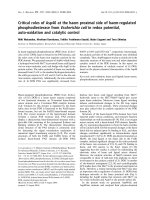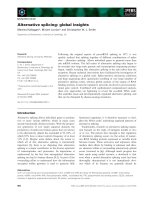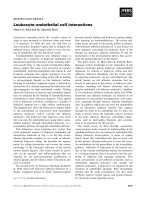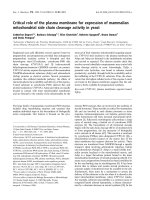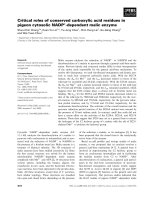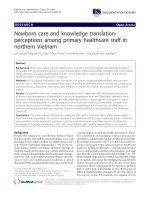Báo cáo khoa học: " Critical care during epidemics" pot
Bạn đang xem bản rút gọn của tài liệu. Xem và tải ngay bản đầy đủ của tài liệu tại đây (37.45 KB, 3 trang )
311
ICU = intensive care unit; SARS = severe acute respiratory syndrome.
Available online />Abstract
We recommend several actions that could improve hospitals’
abilities to deliver critical care during epidemics involving large
numbers of victims. In the absence of careful pre-event planning,
demand for critical care services may quickly exceed available
intensive care unit (ICU) staff, beds and equipment, leaving the
bulk of the infected populace without benefit of potentially life-
saving critical care. The toll of death may be inversely proportional
to the ability to augment critical care capacity, so critical care
health care professionals must take the lead for planning and
preparing to care for numbers of seriously ill patients that far
exceed available ICU beds.
Introduction
We recommend several actions that could improve hospitals’
and communities’ abilities to deliver critical care during
epidemics and bioterrorist attacks involving large numbers of
victims with life-threatening illness. These recommendations
are in part the result of deliberations by the multidisciplinary
Working Group on Emergency Mass Medical Care, which
comprises 33 professionals with expertise in critical care
medicine, biosecurity, disaster preparedness, and infection
control (Rubinson et al., unpublished data).
In countries with widespread critical care capabilities few, if
any, critically ill survivors of traumatic disasters have had to
forgo acceptable critical care because of staff or resource
shortages [1-7]. In contrast, a naturally occurring disease
outbreak or a deliberate epidemic resulting from a covert
bioterrorist attack could generate critically ill victims in
numbers that greatly exceed a hospital’s – or a region’s –
capacity to deliver traditional critical care [8,9] (Rubinson et
al., unpublished data). In the absence of careful pre-event
planning, demand for critical care services may quickly
exceed available intensive care unit (ICU) staff, beds and
equipment, leaving the bulk of the infected populace without
the benefit of potentially life-saving critical care.
It is likely that critically ill victims who present to hospitals early
in the course of the epidemic – that is, some fraction of the
total population who are infected and will become
symptomatic – will receive ‘traditional’ critical care in hospital
ICUs. Even with stockpiling of airway equipment, vaso-
pressors, and mechanical ventilators (which are important
components of the US Centers for Disease Control and
Prevention’s Strategic National Stockpile [10]), shortages of
staff trained in critical care and limited quantities of the vast
array of medications and medical equipment commonly used
in ICUs make it unlikely that current standards of critical care
could be provided for more than just a handful of seriously ill
victims. If immediate evacuation of critically ill patients to
unaffected hospitals or deployment of critical care trained and
equipped medical teams to the affected region are not
possible, then we propose that, in such situations, more lives
could be saved if a circumscribed set of key critical care
interventions were offered to a larger number of patients than
if traditional critical care interventions, with all their incumbent
human and material resource requirements (i.e. usual
standards of critical care), were provided only to a small
number of initial victims (Rubinson et al., unpublished data).
Emergency mass critical care requires modification to
standards of critical care interventions, staffing, equipment,
and triage to provide an acceptable level of care for large
numbers of critically ill victims. At a minimum, hospitals
should plan to be able to deliver to critically ill patients a basic
mode(s) of mechanical ventilation, hemodynamic support,
antibiotic or other disease-specific countermeasure therapy,
and a small set of prophylactic interventions that are
recognized to reduce the serious adverse consequences of
critical illness. A detailed rationale for and specifics of these
recommendations will be provided in a publication from the
Working Group on Emergency Mass Critical Care (Rubinson
et al., unpublished data). We encourage the critical care
community to review these recommendations, revise and
Commentary
Critical care during epidemics
Lewis Rubinson
1
and Tara O’Toole
2
1
Senior Fellow, Division of Pulmonary and Critical Care Medicine, Johns Hopkins University, Baltimore, Maryland, USA
2
Chief Executive Officer and Director, Center for Biosecurity, University of Pittsburgh Medical Center, Baltimore, Maryland, USA
Corresponding author: Lewis Rubinson,
Published online: 27 April 2005 Critical Care 2005, 9:311-313 (DOI 10.1186/cc3533)
This article is online at />© 2005 BioMed Central Ltd
312
Critical Care August 2005 Vol 9 No 4 Rubinson and O’Toole
modify them as deemed necessary, and prepare to implement
rational, modified medical protocols in the wake of a
significant disease outbreak that overwhelms current
capacities to deliver ‘traditional’ critical care.
Triage
During a large or sustained epidemic, even after modification
of critical care standards, available resources will remain
taxed. Priority should be given to people most likely to benefit
from modified critical care interventions. We encourage the
critical care community to develop triage algorithms for
clinical conditions that are likely to be seen in most outbreaks
(e.g. severe sepsis, acute respiratory distress syndrome) that
are based on physiologic parameters, and that are sufficiently
discriminating to identify which patients are most likely to
benefit from emergency mass critical care. We caution
against unvalidated application of triage algorithms originally
designed for use in trauma casualties to victims with medical
illnesses, because these algorithms may not accurately
categorize survival for critically ill medical patients.
A major challenge during an epidemic or other mass casualty
emergency will be to determine when, and on what basis,
traditional standards of critical care are modified to
accommodate emergency conditions, and when modified
standards revert to traditional modes of care. Medical
professionals, hospital staff, and the affected patient
community should actively participate in the development and
review of mass care triage standards and protocols. If
engagement of care givers and the community is neglected,
then mass casualty standards could be misinterpreted and
generate distrust or fail to be implemented during a disaster.
Medical personnel and community members must understand
and agree with the triage plans and be assured that
implementation will be fairly applied to all victims. Extensive
efforts must be undertaken to guarantee that vulnerable
populations will receive equal treatment. Coordination of all
affected hospitals to facilitate implementation of similar
measures under similar conditions and to reinforce the reality
of fairness would be useful, but there is no such ‘organizing
authority’ within the fragmented and mostly private US health
care system.
Achieving situational awareness
In natural disasters or terrorist attacks resulting in traumatic
injuries, a roughly accurate number of surviving casualties
requiring medical care is usually quickly ascertained (within
hours). Epidemics differ from other disasters in that they
unfold over days or even months and years. The scope and
impact of epidemics (whether natural or deliberate) are not
immediately apparent. If a bioattack is discovered to have
occurred (e.g. if several people within a community present
with inhalational anthrax), then it may be impossible to
determine quickly whether there has been one attack or
several or to ascertain rapidly who else is at risk. It is usually
not possible to predict accurately how big an epidemic will
become or how fast it can be quenched. This uncertainty has
important implications for the medical mass casualty
response. How is the decision made to initiate mass casualty
protocols or to turn them off? How do hospitals and other
health care providers plan for and implement sustained
emergency responses unless they know whether an epidemic
is waning or expanding?
In an age of bioterrorism and epidemics of emerging
infectious diseases, it will be necessary to establish
interconnected electronic health information technology
systems with the capacity to track patterns of disease in
populations in near real time. Rapid learning in the face of an
outbreak will be essential. Health information technology
systems that enable sharing and near real time analysis of
aggregated data could be invaluable for illuminating the
course of new or unfamiliar diseases, improving clinical
diagnostic accuracy and treatment efficacy, predicting
disease outcome, and refining triage protocols. Early in an
outbreak a number of treatments may be used, but if they are
administered in an uncontrolled manner at the whim of
clinicians then determination of their effectiveness may be
difficult or impossible. During the severe acute respiratory
syndrome (SARS) outbreak, more than 8000 people became
ill over several months, and a number of treatment modalities
were pursued (e.g. steroids, interferon, and ribaviran), but
none within the context of a clinical trials. Were another large
SARS outbreak to occur tomorrow, clinicians would have no
more clinical trial data on which to base treatment decisions
than they had 2 years ago [11]. To help assess treatments
during the chaotic atmosphere of an outbreak, technology
systems that could capture and aggregate data for large,
simple, near real time clinical trials could be invaluable.
Protection of health care workers and
disease containment
Contagious pathogens present singular operational challenges
that must be anticipated in planning for mass casualty critical
care. Hospitals are typically major sources of secondary
transmission during outbreaks, and the SARS experience
demonstrates that critical care units pose potentially high risks
for disease transmission to health care workers and other
patients [12]. ICUs in Toronto cared for approximately 80
SARS patients over 4 months, and because of secondary
transmission 73 ICU beds (nearly one-third of community and
academic medical center ICU beds) were closed for some
period during the outbreak [13]. The lesson is that secondary
transmission of disease, even with modest numbers of
contagious critically ill patients, may force closure of entire
ICUs or compel isolation of hospital staff, thus decreasing the
critical care capacity just when it is most needed.
All critical care staff should be explicitly and routinely trained
in infection control procedures, including how to don and
remove personal protective equipment without self-
contaminating; what protection is afforded by different levels
313
of personal protective equipment; and what environmental
controls must be employed for given situations. Because
illness due to newly emergent pathogens or to bioweapons
may present with signs and symptoms that are seen
commonly in critically ill patients, and because relevant, point-
of-service rapid diagnostic tests are not likely to be available
at the outset of a disease outbreak, leaders of critical care
units should consider implementing droplet and contact
precautions for all critically ill patients with febrile respiratory
illnesses, even during non-outbreak conditions.
Conclusion
Historically, critical care has played only a small role in the
response to disasters, but the nature of disasters in the era of
globalization and catastrophic terrorism is changing. The toll
of death, morbidity, and public confidence wreaked by a
deliberate or naturally occurring epidemic of infectious
disease may be highly dependent on the critical care
response. Critical care providers must take the lead in
planning and preparing to care for numbers of critically ill
patients that far exceed available ICU beds.
Competing interests
The author(s) declare that they have no competing interests.
References
1. Auf der HE: Disaster planning, part II. Disaster problems,
issues, and challenges identified in the research literature.
Emerg Med Clin North Am 1996, 14:453-480.
2. Gutierrez de Ceballos JP, Fuentes FT, Diaz DP, Sanchez MS,
Llorente CM, Guerrero Sanz JE: Casualties treated at the
closest hospital in the Madrid, March 11, terrorist bombings.
Crit Care Med 2005, 33:S107-S112.
3. Frykberg ER: Medical management of disasters and mass
casualties from terrorist bombings: how can we cope? J
Trauma 2002, 53:201-212.
4. Arnold JL, Halpern P, Tsai MC, Smithline H: Mass casualty ter-
rorist bombings: a comparison of outcomes by bombing type.
Ann Emerg Med 2004, 43:263-273.
5. Singer P, Cohen JD, Stein M: Conventional terrorism and criti-
cal care. Crit Care Med 2005, Suppl:S61-S65.
6. Kluger Y, Peleg K, Daniel-Aharonson L, Mayo A: The special
injury pattern in terrorist bombings. J Am Coll Surg 2004, 199:
875-879.
7. Shamir MY, Weiss YG, Willner D, Mintz Y, Bloom AI, Weiss Y,
Sprung CL, Weissman C: Multiple casualty terror events: the
anesthesiologist’s perspective. Anesth Analg 2004, 98:1746-
1752.
8. World Health Organization: Health Aspects of Chemical and Bio-
logical Weapons. Report of a WHO Group of Consultants.
Geneva: World Health Organization; 1970.
9. US Congress, Office of Technology Assessment: Proliferation of
Weapons of Mass Destruction: Assessing the Risks. Washing-
ton, DC: Office of Technology Assessment, US Congress; 1993.
10. Prior SD: Who you Gonna Call? Responding to a Medical
Emergency with the Strategic National Stockpile. The Center
for Technology and National Security Policy. .
edu/ctnsp/stockpile.htm. Accessed April 23, 2005
11. Muller MP, McGeer A, Straus SE, Hawryluck L, Gold WL: Clinical
trials and novel pathogens: lessons learned from SARS.
Emerg Infect Dis 2004, 10:389-394.
12. Scales DC, Green K, Chan AK, Poutanen SM, Foster D, Nowak K,
Raboud JM, Saskin R, Lapinsky SE, Stewart TE: Illness in inten-
sive care staff after brief exposure to severe acute respiratory
syndrome. Emerg Infect Dis 2003, 9:1205-1210.
13. Booth CM, Stewart TE: Communication in the Toronto critical
care community: important lessons learned during SARS. Crit
Care 2003, 7:405-406.
Available online />
